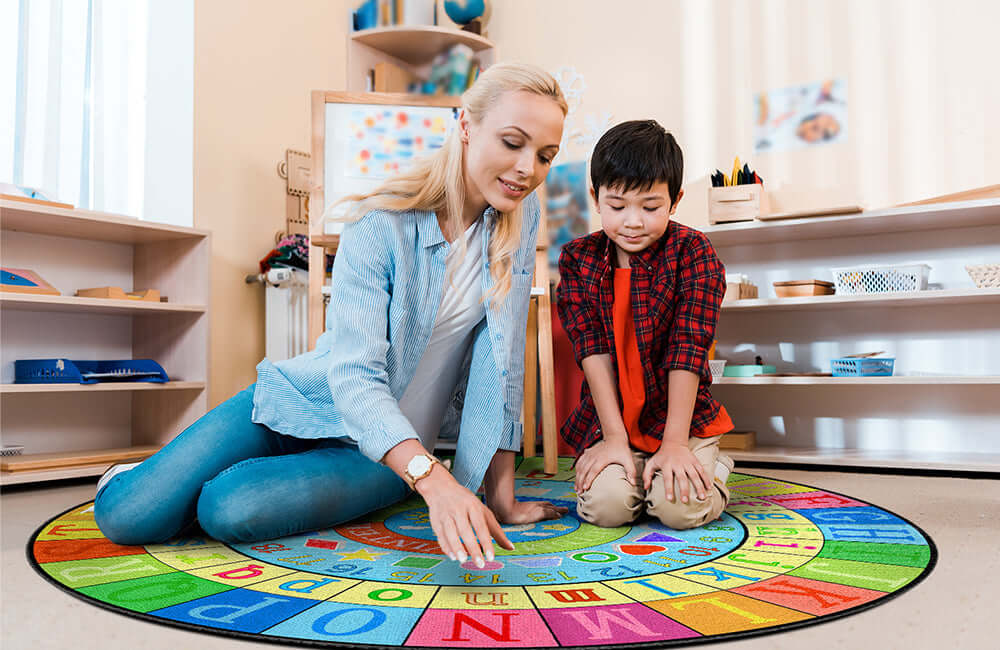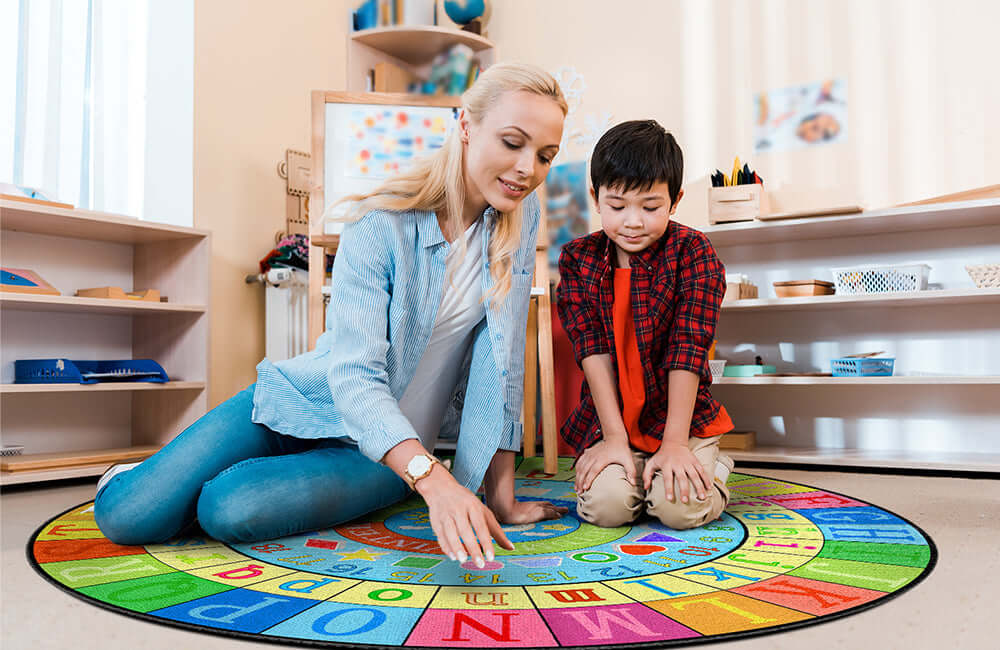Walk into any thriving early childhood classroom, and you'll likely find a circular rug at its heart.
This seemingly simple classroom rug has evolved from a basic furnishing to an essential tool for modern learning environments.
Round rugs aren't just decorative elements—they're transformative spaces that reshape how young children interact, learn, and develop crucial skills.
As educators continue to explore innovative approaches to early learning, the humble round rug has emerged as a powerful ally in creating dynamic educational spaces.
Let's explore why circular gathering spaces are making such an impact in early childhood education.
The Psychology of Circular Spaces
The shape and style of our environment—whether traditional or featuring stylish boho classroom rugs—profoundly influences behavior and interaction.
Research on environmental psychology suggests that circular arrangements naturally promote feelings of community and equality.
Unlike rectangular or square formats where hierarchy can be implied through positioning, circles create environments where everyone is equally positioned relative to the center.
For young children developing their sense of social awareness, this subtle environmental cue reinforces belonging and equality.
Within a circle, every child can see every other participant, making communication more direct and engaging.
Benefits for Circle Time Activities
Circle time has been a staple for decades, but its effectiveness is enhanced by using purpose-built classroom seating rugs that organize the physical environment.
Round rugs offer several distinct advantages:
Visual Boundaries
Young children often struggle with spatial awareness and understanding invisible boundaries. A round rug creates a clear, visual boundary that helps children understand where the activity space begins and ends. This natural boundary helps with:
- Classroom management
- Transition between activities
- Spatial awareness development
- Group cohesion
Enhanced Engagement
When seated in a circle on a round rug, children naturally face inward toward the teacher and each other. This improves attention and engagement during:
- Story time sessions
- Group discussions
- Show-and-tell presentations
- Musical activities
- Collaborative problem-solving
Development of Social Skills
The circular formation encourages eye contact, turn-taking, and active listening—fundamental social skills that will benefit children throughout their lives. These arrangements help children develop:
- Respect for others' speaking time
- Non-verbal communication cues
- Group participation skills
- Democratic discussion patterns
Creating Inclusive Learning Environments
Round rugs naturally lend themselves to creating more inclusive educational environments.
Their shape eliminates front or back rows, ensuring that no child feels relegated to a less important position in the classroom community.
For children with diverse needs, circular arrangements offer distinct advantages:
- Children with hearing impairments can better see all participants
- Students with attention challenges benefit from clearer visual focus
- Children with mobility differences can be positioned to maximize participation
- Shy or reserved children feel less "spotlighted" than in linear arrangements
According to the Journal of Inclusive Education, "Classroom arrangements that prioritize equality of positioning and clear sightlines promote greater participation from all students, regardless of their learning differences."
Versatility in Classroom Design
One of the greatest strengths of round rugs in educational settings is their versatility. Unlike fixed furniture or built-in seating, round rugs can:
- Define multiple activity zones within one classroom
- Be easily relocated as classroom needs change
- Function as both instructional and play spaces
- Accommodate varying group sizes with natural expansion and contraction
Many educators at Boooom Jackson have discovered that round rugs can transform throughout the day, serving as:
- Morning meeting spots
- Cozy reading rugs for nooks during independent work time
- Performance spaces on vibrant colorful classroom rugs for creative play
- Collaborative workspaces for small group projects
- Calm-down areas utilizing soft pastel classroom rugs for emotional regulation
Choosing the Right Round Rug
Not all round rugs are created equal for educational purposes. When selecting a round rug for your learning environment, consider:
Size
The diameter should accommodate your largest regular group activity with children seated comfortably.
For most early childhood classrooms, choosing large classroom rugs between 6-9 feet in diameter provides adequate space while maintaining intimacy.
Material
Look for rugs that are:
- Stain-resistant and easy to clean
- Low pile for easy movement of chairs and mobility devices
- Durable enough to withstand daily use
- Free from harmful chemicals and irritants
Design Elements
Many educational rugs incorporate learning elements like:
- Alphabet borders
- Number sequences
- Color identifiers
- Geometric patterns
- Seating spots or markers
For specialized options, explore our educational rug collection which features designs specifically created for developmental appropriateness.
Conclusion
As we continue to evolve our understanding of how physical environments impact learning, the simple round rug emerges as a powerful tool in early childhood education.
Far more than just floor covering, these circular spaces create communities, foster engagement, promote inclusion, and offer versatility that supports the dynamic nature of early learning.
By thoughtfully incorporating round rugs into learning environments, educators can literally and figuratively create circles of learning that benefit all children.
The next time you see young learners gathered in a circle, take note of how this simple spatial arrangement creates opportunities for connection, communication, and collaborative learning.




Leave a comment
This site is protected by hCaptcha and the hCaptcha Privacy Policy and Terms of Service apply.